

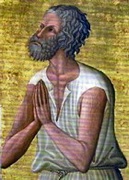
The Blessed Peter Crisci, who was born in ca. 1243 in Foligno, sold his inheritance when he was about 30 and gave the proceeds to the poor. From this point, he dressed in sacking and lived as a hermit in a cell in the campanile of the Duomo (now the Cella di San Pietro Crisci). He regularly preached in the Duomo and became highly venerated.
He was regarded as a madman in some quarters. While saintly laymen like St Francis had been acceptable in the 13th century, they were generally only accepted in the 14th century when they had the patronage of the mendicant orders. Peter therefore received the attentions of the Inquisition, but he was judged to be orthodox. Not all of his compatriots treated him kindly, For example, the Blessed Angela of Foligno records that, before her conversion (in ca. 1285), "I used to make fun of a certain Petruccio, but now I could not do otherwise than follow his example".
Peter died in his cell in 1323 and was buried in the Duomo.
Relics of the Blessed Peter Crisci
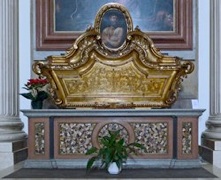
Ludovico Jacobilli recorded (in 1626) that the Compagnia della Carità (also known as the Compagnia dei Preti) built a chapel in the Duomo in 1385 that was dedicated to their patrons, both of whom were from Foligno: the Blessed Peter Crisci and St Dominic of Sora. The relics of the former were housed here in a reliquary made of crystal and gold. (This chapel stood on the site of the present Baptistery).
An inventory that was compiled in 1771 recorded that the relics were removed from this chapel on 26th August of that year. It was presumably at about this time that they were transferred to the present gilded wooden reliquary and moved to the Cappella Jacobilli.
The relics were removed for scientific investigation in October 2009 and returned to the reliquary, which is now in the left transept.
Cult of the Blessed Peter Crisci
Bishop Giovanni Angeletti (1364-92) commissioned a legend of the Blessed Peter Crisci from the Dominican Brother Giovanni Gorini di San Geminiano. The first indication that a cult dedicated to the Blessed Peter Crisci emerged in Foligno dates to 1381, when the existence of a fair held on the anniversary of his death was first documented.
The cult seems to have been encouraged by Ugolino III Trinci (1386-1415), and it was probably at his instigation that Pope Boniface IX granted indulgences (in either 1391 or 1400, according to different readings of the damaged document) to those praying before the relics “in festo sancti Petri”. (Boniface IX granted similar indulgences in respect of Blessed James of Bevagna, despite the fact that neither of these men had been canonised. Unlike James, Peter Crisci never seems to have been the subject of a canonisation process. )
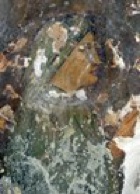
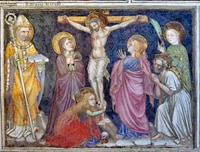
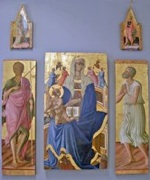
Crucifixion (1424) San Salvatore Polyptych (1432)
by Ottaviano Nelli by Bartolomeo di Tomasso
Chapel of Palazzo Trinci Museo Diocesano
The works of art illustrated above demonstrate the continuing devotion of the Trinci family to the cult of the Blessed Peter Crisci:
-
✴he is depicted in the fresco that Corrado Trinci commissioned for the chapel of Palazzo Trinci in 1424; and
-
✴he is depicted in the polyptych that Prior Rinaldo Trinci commissioned for the high altar of San Salvatore in 1432.
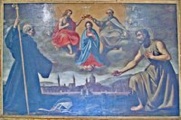
Coronation of the Virgin and saints (1626)
attributed to Noel Quillerier, Museo Diocesano
In 1626, when Ludovico Jacobilli requested permission from the Cathedral Chapter to place “il quadro del Beato Pietro Crisci” (illustrated above) in the Cappella di San Domenico di Sora e il Beato Pietro Crisci. This coincided with the publication of an edition of the Vita del Beato Pietro da Foligno by Nicolò Barnabò. In 1628, the feast of the Blessed Peter was registered as a “duplex majus” (major feast) in the official calendar of the diocese. These developments probably indicate a revival of the cult ahead of the “Decretum pro patronis in posterum eligendis” (1630), which insisted that the patron saints of cities should be selected from those who had received papal canonisation and/or whose names were already in the Roman Martyrology.
Read more:
M. Sensi and F. Frezza (Eds), “Pietro Crisci, Beato, Confessore, Compatrono di Foligno” (2010) Foligno
Return to Saints of Foligno.

